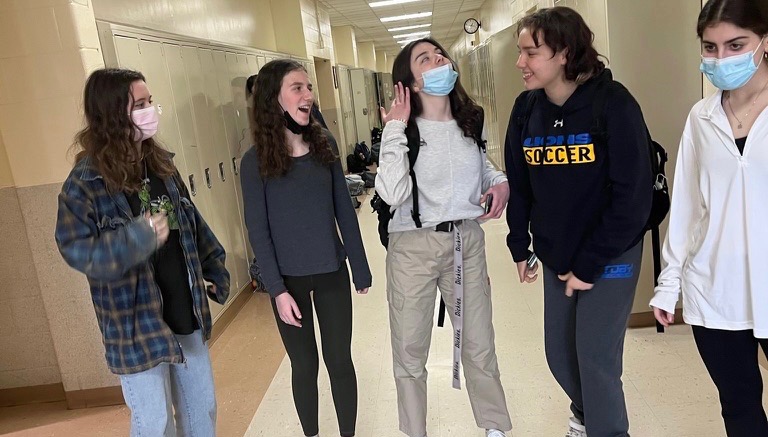Pro/con: Implementing school uniforms
March 29, 2022

Pro
Each morning I wake up, brush my teeth, wash my face and then have to make the decision of what to wear to school that day. While it seems like an easy choice, it can quickly grow overwhelming as I consider each option. Should I wear sweatpants and feel more comfortable? Should I wear jeans and look more put together? While the 15 minutes I spend each day choosing what to wear doesn’t seem like much, the time adds up.
This is just my experience, but in general, school uniforms allow students to focus on their education rather than their clothing. In a world where trends and social media are prevalent, it is easy for students to get caught up in what they are wearing rather than solely focusing on their education at school.
The National Association for Secondary School Principals stated, “When all students are wearing the same outfit, they are less concerned about how they look and how they fit in with their peers; thus, they can concentrate on their schoolwork.” This is further supported by a study through The University of Houston that revealed, “elementary school girls’ language test scores increased by about 3 percentile points after uniforms were implemented.”
Additionally, school uniforms are more inclusive to students who can’t afford all the latest trends. I have heard many of my friends’ say phrases like “oh, I wish I had what she had” or “she always has the best clothes.” Having a school uniform can help reduce jealousy among students, which will lead to a more inclusive and supportive learning environment.
Furthering this idea of inclusivity, one of CESJDS’s core values is kehillah, meaning community. Uniforms would reinforce this idea of community, as wearing them provides a sense of unity and belonging. According to a study conducted by Linda Abel Fosseen, 1,000 Texas middle school students reported that wearing a school uniform gave them “significantly more positive perceptions of belonging in their school community than reported by students in the standard dress group.”
While some may think that students lose their right to freedom of expression in uniforms, I argue that students can still express themselves in uniforms through accessories, hairstyles, etc. Additionally, clothing is not the only way students can express themselves during class times; there are many other mediums including art, writing and music.
Finally, the implementation of uniforms can help get rid of pre-existing issues with both the dress code and security. The usage of uniforms would make the dress code easier to enforce, which would lead to less controversy amongst students and faculty. Additionally, many students are not fans of the school ID badges that are used to identify if they go to JDS. Uniforms make it clear who attends JDS, which may lead to getting rid of student ID badges.
I get it. We teens don’t like being told what to do. And at JDS, we don’t even like being told to wear ID badges. But think of uniforms as lessening our to-do list – one less thing to worry about each day.
All in all, school uniforms foster inclusion and unity and push students to focus more on their education. I highly suggest that JDS considers the implementation of school uniforms.

Con
Having to wear bland colors, tight itchy pants and weird ties is not an experience I signed up for when deciding to go to a pluralistic school. Imposing school uniforms would go against everything that CESJDS stands for.
JDS is one of few pluralistic Jewish day schools across America, and it prides itself specifically on its ability to cultivate environments that are open-minded, welcoming, tolerant and diverse. School uniforms embody the opposite of those values. They strip students’ individuality and force them to conform to outdated traditional gender roles.
For boys, standard school uniforms include collared, buttoned shirts, ties and khakis. For girls, the shirts and ties are usually the same, but tighter. Instead of pants, girls usually have to wear skirts and socks that cut strangely below the knee. Many schools nowadays allow girls to wear trousers, but even if JDS were to provide this choice, the options would still be limited.
In today’s society, girls wearing pants has been mostly normalized, but what if a masculine student wants to wear a skirt or a dress? Gendered school uniforms stifle gender expression and limit students’ ability to explore and affirm their identities.Even with all the variation JDS could provide, we need to be able to explore both our gender and sexual identities, and clothing is an excellent way to do that. If a school uniform was enforced, it’s impossible to tell how many queer people would feel erased or even unwelcome. Letting us dress ourselves gives us the opportunity to express whatever we want, creating a safer and more comfortable environment for us to learn in.
School uniforms not only reinforce traditional gender roles but they also perpetuate the issues of sexism. The Australian Council for Health, Physical Education and Recreation organized a study focusing on students’ physical activity level and found that certain school uniforms actually discourage girls from participating in physical activities. We shouldn’t add another obstacle that prevents girls at JDS from achieving their full potential.
Being able to wear whatever we want, specifically at a Jewish day school, enriches our religious education. We’re able to see so many different types of Jews, practicing and non-practicing, who wear different types of clothes. This helps us recognize that all of them are equally Jewish and how clothing does not define the legitimacy of someone’s faith. A uniform, although unintentionally, would teach us to think that Jews should only look or dress one way.
Additionally, it is a common myth that school uniforms ease the financial burden of teenagers buying clothes. According to a study by the Family and Consumer Sciences Research Journal, researchers found that uniforms do not replace a student’s clothing, and parents end up spending more money on clothes when uniforms are required. I mean, we’re still teenagers. Implementing school uniforms only adds to the list of clothes that we will inevitably wind up buying, not to mention extra costs for tailoring.
Getting uniforms tailored is a common occurrence when schools require them. Teenages bodies are constantly fluctuating and changing, so it’s expected of students to get them fitted to their size.
Child and teen development specialist Robyn Silverman told NBC News’ Today that students, especially female students, tend to compare how they look in their uniforms with others: “As a body image expert, I hear from students all the time that they feel it allows for a lot of comparison… So if you have a body that’s a plus-size body, a curvier body, a very tall body, a very short body, those girls often feel that they don’t look their best.” Arizona State University also did a study on this and found that “students from schools without uniforms reported higher self-perception scores than students from schools with uniform policies.”
Uniforms do nothing to make people feel more included or comfortable in school. What actually makes us feel secure in school is being able to choose and express ourselves however we want. Even if there are others who aren’t particularly fond of your outfit, it doesn’t matter because you chose it and you feel confident in it. Forcing students to wear the exact same outfits just makes everyone compare and constantly judge themselves against others.
School uniforms, especially at JDS, would take away from the diverse Jewish perspectives that students experience and would suppress students’ identities. I get that it’ll be easier to get dressed in the morning, at least for students who are comfortable in the set of gendered and monotonous clothing that the administration prescribes, but for a pluralistic school, enforcing uniforms would be a pretty totalitarian decision.

